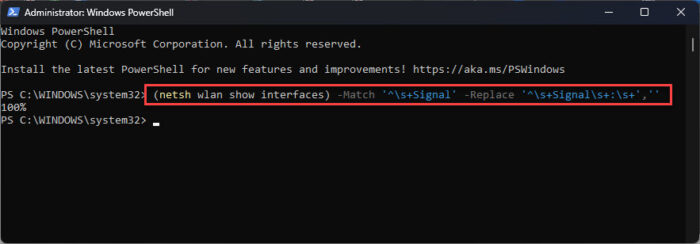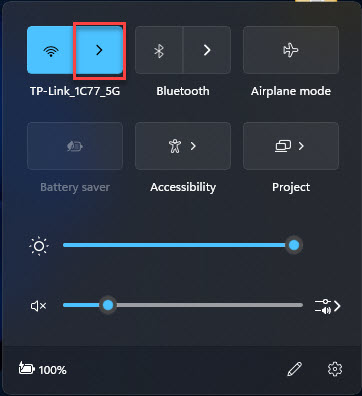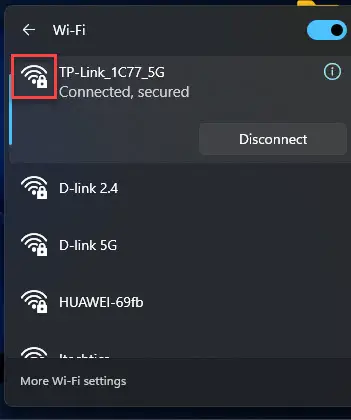Key Points
- To check the signal strength from the Command Prompt, run the command “netsh wlan show interfaces | find “Signal”“. For PowerShell, use the command “(netsh wlan show interfaces) -Match ‘^\s+Signal’ -Replace ‘^\s+Signal\s+:\s+’,”“
- You can also check the Wi-Fi signal strength from the Quick Access menu, the Task Manager, the Settings app (Settings > Network & internet > Wi-Fi), the Control Panel (Control Panel > Network & internet > Network and Sharing Center), and the Network Connections applet.
Getting the best possible internet speeds is what everyone desires. Instant page loadings, quick downloads, and high-res streaming are what one needs. To achieve this, good internet bandwidth and a reliable ISP are insufficient – you must also have good wireless signals.
Wi-Fi signals are radio waves transmitted from the wireless router or access point, which are then received by your wireless device, and vice versa. This is how data is exchanged between the devices, and subsequently, the internet. However, if you are farther away from the wireless access point, you will experience slower internet speeds.
This is why it is important that you know the strength of the Wi-Fi signals your device is receiving from the router, as it may be the cause of bad internet speeds.
Windows 11 provides several native methods you can use to determine the wireless signal strength for your current Wi-Fi connection, which have been discussed in this post. But before we learn the methods, it is important to understand what qualifies as a good signal strength.
Learn how to check Wi-Fi signal strength in Windows 10.
Table of Contents
What is a good Wi-Fi signal strength?
Wi-Fi signals are directly compared to their reliability. Having a reliable internet connection automatically means that the Wi-Fi signal strength on the device is good.
Wi-Fi signals are actually measured in decibels (dBs). A Wi-Fi signal strength ranges between -30dBm and -90dBm. The higher the number, the greater the signal strength. This means -30dBm means maximum signal strength, and -90dBm means no Wi-Fi signals at all.
Here is a table of Wi-Fi signal strength and its quality expectations:
| SIGNAL STRENGTH (dBm) | Details |
|---|---|
| -30 | Maximum possible signal strength. |
| -50 | Excellent signal strength. |
| -60 | Good signal strength. |
| -67 | Reliable signal strength. |
| -70 | Relatively weak signal strength. |
| -80 | Unreliable. Most services will not work. |
| -90 | Possibility of disconnection. |
That said, the Windows OS does not measure or display the signal strength in decibels. Instead, it shows a percentage (through certain methods only), or a visual representation of the signal strength.
If you find the Wi-Fi signal strength in percentages, you can then use it to convert it into decibels using a specific formula (given below).
Let us now continue to see how you can obtain the quality of the Wi-Fi signal on your Windows 11 PC.
Check Wi-Fi signal strength from the Command Prompt
To obtain a percentage of your Wi-Fi’s signal strength you must use the command line. Both the Command Prompt and the Windows PowerShell can be used for this purpose.
To check the wireless signal strength from the Command Prompt, perform these steps:
-
Press the Windows key + R to launch the Run Command box.
-
Type in “cmd” and press Enter to open the Command Prompt.
-
Execute the following command:
netsh wlan show interfaces | find "Signal"
Check Wi-Fi signal strength from Command Prompt
After performing the steps above, you will see the wireless signal strength in percentages. This will help you determine whether the wireless signal strength is the problem with your internet speeds or not.
Check Wi-Fi signal strength from PowerShell
You can also check the Wi-Fi signal strength using PowerShell. However, the information you get is similar, which is the signal strength in percentages.
Run the following command in PowerShell to obtain the Wi-Fi signal strength percentage:
(netsh wlan show interfaces) -Match '^\s+Signal' -Replace '^\s+Signal\s+:\s+',''
Now that you know the quality of the Wi-Fi signal strength, you can convert it to decibels so that you can determine whether your device has a reliable internet connection or not (conversion method given below in this post).
Check Wi-Fi signal strength from Quick Access menu
While the methods discussed above display the wireless signal strength in percentages, the other methods do not give such detailed information. While you can get a ballpark of the Wi-Fi signal strength, these methods are not sufficient to get a decibel count for the signal strength.
That said, you still get the gist of where the signal strength lies at the click of a few buttons, without running any commands.
The quickest way to check the Wi-Fi signal strength is through the Wi-Fi settings in the Quick Access menu. The icon for the Wi-Fi network flyout in the Quick Access menu is dynamic and adjusts itself according to the Wi-Fi signal strength.
Here is how you can check the WiFi signal strength from the Quick Access menu:
-
Click on the Quick Access menu in the taskbar to expand it.

Expand the Quick Access menu -
Now expand the Wi-Fi menu by clicking on the arrow next to the Wi-Fi signals.

Expand the Wi-Fi menu -
Look for the solid number of bars in the wireless icon for the active Wi-Fi connection to determine the strength.

Check Wi-Fi signal strength from the Quick Access menu
As in the image above, the greater the number of curvy lines, the greater the signal strength.
Each line represents 25 percent Wi-Fi signal strength. This means that, in the image above, the device is getting maximum Wi-Fi signals somewhere between 75 and 100 percent. If these were just 2 lines, it would mean that the signal strength is somewhat between 25 and 50 percent.
Check Wi-Fi signal strength from Settings
You can also get a ballpark value of Wi-Fi signal strength using the Settings app in Windows. However, it would provide the same information as you can get from the Quick Access menu, which is the number of bars in the wireless icon.
Here are the steps to check the Wi-Fi signal strength from the Settings app in Windows 11:
-
Press the Windows key + i to launch the Settings app.
-
Click “Network & internet“.
-
Click Wi-Fi..

Open Wi-Fi settings -
Check the number of signal bars in the icon left of the network’s name, as highlighted in this image:

Check Wi-Fi signal strength from Settings
The full 4 bars in the image above signify a full signal strength. However, if the signal strength was lower, it would display fewer strength bars, since the icon is dynamic.
Check Wi-Fi signal strength from the Control Panel
Use the following steps to check the Wi-Fi signal strength from the Control Panel:
-
Press the Windows key + R to launch the Run Command box.
-
Type in “control” and press Enter to launch the Control Panel.
-
Click “Network and Internet“.
-
Open the “Network and Sharing Center“.
-
Look at the wireless icon next to “Connections” which shows the signal strength of your Wi-Fi connection.

Check Wi-Fi signal strength from the Control Panel
Check Wi-Fi signal strength from Task Manager
In Windows 11, you can also check the Wi-Fi signal strength from the Task Manager in a few easy steps. Here is how:
-
Press CTRL + Shift + Esc to open the Task Manager.
-
Switch to the Performance tab.
-
Open the “Wi-Fi” category.

Open the Wi-Fi performance tab -
Check the Wi-Fi signal strength from the bars in front of the “Signal strength” field.

Check Wi-Fi signal strength from the Task Manager
Check Wi-Fi signal strength from Network Connection applet
While the Network Connections applet is a part of the Control Panel, it provides a different approach for checking the Wi-Fi signal strength on your Windows PC than the one already discussed. The following steps can also be used to check the Wi-Fi signal strength on a Windows 11 computer:
-
Press the Windows key + R to launch the Run Command box.
-
Type in “ncpa.cpl” and press Enter to open the Network Connections applet.
-
Right-click the wireless network adapter and click Status.

Check status of wireless network adapter -
Now look at the bars in front of “Signal quality” to determine the Wi-Fi signal strength.

Check Wi-Fi signal strength from the Network Connections applet
This concludes all the methods to check the Wi-Fi signal strength in Windows 11 natively.
While some methods only show you the ballpark for the Wi-FI signal strength, other methods give a precise percentage, which can be used to convert the values into decibels for the signal strength.
Check Wi-Fi signal strength using third-party apps
Other than these Windows-native methods, you can also use third-party apps to check the Wi-Fi signal strength for the wireless network that you are connected to. Not only that, but such apps also have other abilities. For example, some apps can tell you the signal strength for all the wireless networks in your vicinity.
Here are a few useful and safe apps that you can use the determine the Wi-Fi signal strength:
Calculate Wi-Fi signal strength in decibels
If you know the quality of the signal strength your device is receiving in percentages, you can convert it to decibels and then determine whether it is an excellent, good, or weak signal strength using the table given at the start of this article.
Use the formula given below to convert your signal strength in percentage (quality) into decibels (dBm):
-dBm = (Quality/2) -100
For example, if the percentage of the signal strength you determined from the command line is 80%, then you will use the formula as in the example below:
(80/2) -100 = -60 dBm
According to this example, the Wi-Fi signal strength is good. However, it still has room for improvement.
You can also invert the formula to convert decibels into quality percentages if you are using a third-party application to determine Wi-Fi signal strength which gives the strengths in decibels instead of percentages.
How to improve the Wi-Fi signal strength
If you find that your PC is not getting the wireless signal strength it needs for a reliable and speedy internet connection, there are a few things you can do to improve it.
Relocate router
The location of the router is very important. Make sure that it is not stuffed into a cupboard and is placed centrally in your environment to cover maximum space around it. Moreover, no other electronic or magnetic objects surround the router as they add to the attenuation, which is the loss of signals.
Moreover, radiowaves of 2.4, 5, and 6 GHz are subject to interference from obstacles as well as other wave-emitting devices. Therefore, make sure that the number of obstacles between the access point and your device is minimal, and that other wave-emitting devices are as far away as possible.
Update router firmware
You can try and update the router’s firmware to improve the signal strength.
Firmware updates are essential to be installed as they ensure that the latest technology and drivers are supported and the device performs to its level best. Updating the firmware could potentially make better use of the router’s antennas and emit stronger Wi-Fi signals.
Minimize obstacles
As mentioned earlier, the best signal strength can be experienced when the router and the end device are in each other’s line of sight, meaning no objects in the middle are interfering with the signals.
The more objects, the greater the attenuation and signal loss. Therefore, make sure that a minimum number of objects are present between the access point and your device to improve the Wi-Fi signal strength.
Switch Wi-Fi channel
It may be possible that the channel within the Wi-Fi band is experiencing interference from other devices using the same channel. You should try and switch the channel of your device and check if the signal strength has improved.
Simply log into the router and change its operational channel so that yours is a unique one. this will result in minimal interference from other radiowaves working within the same range.
How to check Wi-Fi channels in use around you
Add range extender
A range extender is a device that re-strengthens the Wi-Fi signals from the original router and broadcasts the signals. If nothing else seems to work for you, you can use a range extender to amplify the signals of the router to obtain better Wi-Fi signal strength.
Closing words
The Wi-Fi signal strength your device is receiving plays a huge role in the experience you are getting when using the computer. If the signal strength is weak, the pages will load slower, the downloads will be slow or even, get interrupted, and you will become frustrated very soon.
Rather than complaining about the internet quality of the service provider, I recommend that you first confirm that your device is receiving sufficient wireless signals, so the fault is not at your end.
While the world is moving on to Wi-Fi 7 and 6 GHz bandwidth, to be able to get the best internet experience, your device must still have a good signal bandwidth. This article illustrates the methods you can use to determine what kind of Wi-Fi signals your device is receiving so you can make the necessary changes for further improvement if needed.



